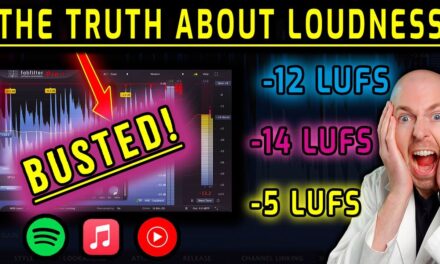
Understanding Phase for PRO Drums Mixes: A Comprehensive Guide

Easiest Way to Find & Fix PHASE Issues for PRO Mixes
👉 Download My FREE Rock & Metal Mixing Cheat Sheet: bit.ly/2N3vp6K
Introduction
If you’ve ever struggled to understand what phase means or what proper phase alignment is, this guide is here to help. Phase issues can drastically impact the clarity and power of your mix, and understanding how to manage them will ensure your recordings always sound their best. This article will break down the concept of phase, explain its effects on your music, and provide real-world examples using drum replacement software. By the end, you’ll be equipped with the knowledge to keep your drum samples, guitars, and other instruments properly aligned.
As a thank-you for your time, there’s a free rock and metal mixing cheat sheet available for download. It contains useful starting points for EQ and compression, helping you quickly dial in great sounds.
What is Phase?
In audio engineering, phase refers to the position of a sound wave within its cycle. All sound waves travel in repeating cycles, moving up and down. When discussing phase, we analyze how the peaks and valleys of two different sounds align with each other.
- In Phase: When two sounds are in phase, their peaks and valleys match up. This results in a fuller, more powerful sound.
- Out of Phase: When two sounds are out of phase, the peaks of one wave align with the valleys of another. When perfectly out of phase (180 degrees out), the sounds cancel each other out, leading to a weak or even silent signal.
A helpful analogy is ocean waves: If two waves rise and crash together at the same time, they create a larger wave. However, if one wave is rising while another is falling, they cancel each other out, leaving the water flat. The goal in mixing is to minimize this cancellation effect and maintain the full impact of the sound.
Understanding Phase Shifts
Audio is not simply either in phase or out of phase; it exists on a spectrum. Shifting a waveform slightly alters how it interacts with another sound. For example, if two identical tones are played together, they add up to a louder version. But if one is shifted slightly, the result changes depending on how their peaks and valleys align.
Using a plugin like Sub Ninja by The Him DSP helps visualize these shifts. By nudging a waveform out of alignment and observing the changes, we can see how phase affects the final output. As phase shifts increase, audio levels may drop, and certain frequencies may cancel out, making the sound feel thinner and less present.
Phase and Complex Sounds
Unlike simple tones, instruments like guitars and drums produce a wide range of frequencies. When elements of these complex sounds go out of phase, only specific frequency ranges may cancel out, creating inconsistencies in the mix. For example, shifting the phase of a drum track may cause some frequencies to disappear while others remain. This phenomenon can be challenging to identify, even for experienced engineers.
To illustrate this, imagine mixing a snare drum with two layers: one providing snap and another adding body. These layers must be aligned correctly to prevent unwanted phase cancellation, which could thin out the drum sound instead of making it punchy and full.
Practical Example: Aligning Drum Samples
Many home studio engineers use drum replacement software to enhance live recordings. A common issue when layering drum samples is phase misalignment between the original recording and the sample. This occurs because waveforms combine when played simultaneously, and if they’re not correctly timed, certain frequencies may cancel out.
For example, using Trigger 2 by Steven Slate, we might layer a snare top mic with a snappy sample. To ensure proper phase alignment, we:
- Compare waveforms visually to check if they are aligned.
- Listen for any loss of punch, particularly in the low-mid frequencies (around 200 Hz).
- Use polarity inversion (a tool in all major DAWs) to test if flipping the phase improves the sound.
- Focus on the most critical part of the sound, such as the body of the snare, when making phase adjustments.
By following these steps, we can determine the best phase relationship for a full and powerful drum sound.
Kick Drum Phase Alignment
A similar approach applies to kick drums, where low-frequency energy is crucial. If two kick samples are layered, they must be phase-aligned to maintain their impact. Using Sub Ninja, we can:
- Analyze each sample’s low-end frequencies.
- Combine the samples and observe the waveform changes.
- Flip the polarity of one sample to test for better alignment.
If the waveform shrinks when flipped, it means phase cancellation is occurring, reducing the low-end power. Keeping the samples properly aligned ensures a balanced mix with both punch and sub energy.
Managing Phase in Multi-Mic Setups
When recording with multiple microphones, phase issues naturally arise due to the time it takes for sound to reach each mic. For example, in a drum recording, various mics capture sound from different angles and distances, creating complex phase relationships.
To systematically handle phase alignment in such situations:
- Start with close microphones (e.g., snare top and bottom, kick in and out).
- Use polarity inversion to test which settings maintain the strongest fundamental frequencies.
- Gradually incorporate room and overhead mics, ensuring their phase complements the primary sources.
In our journey to achieve the best possible drum mix, we’ve explored the concept of phase and how it affects the overall tone and clarity of our recordings. As we near the final stages of this discussion, it’s essential to focus on the role of drum cymbals and room mics in relation to phase alignment.
Optimizing Cymbal Phase
Once you’ve optimized the low end of a kick drum and the punch of a snare, it’s crucial to check how your drum cymbals interact with the rest of the kit. Since some of the snare and kick sounds bleed into these microphones, their phase alignment can significantly impact the final mix.
When adjusting the polarity of cymbals, a common issue is flipping between multiple tracks to find the best setting. A more effective approach is to send all your cymbal tracks to a bus or group track and invert the polarity from there. This method allows you to hear the overall phase impact more clearly and prevents losing sight of your mix’s sonic vision.
Filtering Low Frequencies for Clarity
As you adjust the polarity of your cymbals, pay close attention to the low-end response of your kick drum and the punch of your snare. If you notice unwanted interference in the low end caused by room or cymbal mics, a practical solution is to filter out sub frequencies from those channels.
To achieve this, use a linear phase EQ to avoid unwanted phase distortions. For example, in one scenario, a high-pass filter set at around 180 Hz was applied to the room bus using a linear phase EQ. This effectively removed conflicting low-end frequencies that could otherwise muddy the mix. Implementing this technique helps to maintain clarity in the low-frequency spectrum while preserving the natural sound of the drums.
The Bigger Picture: Trust Your Ears
Despite technical tools and phase-alignment techniques, the key to a great drum mix is trusting your ears. The reality is that achieving perfect phase alignment across all microphones is nearly impossible. Instead of obsessing over perfection, focus on enhancing the key characteristics that define your drum sound—such as a punchy snare and a powerful kick drum.
Recap: Key Takeaways
To summarize everything covered in this guide:
- Phase refers to the timing difference between two sound sources, influenced by microphone placement and distance.
- Phase issues are inevitable but only problematic when they negatively impact the desired tone of your mix.
- Instead of nudging samples to achieve perfect alignment, use polarity inversion to enhance the most critical frequencies.
- Tools like oscilloscopes (e.g., Sub Ninja) can visually confirm phase cancellation but should not replace critical listening.
- Rather than focusing solely on individual drum samples, phase optimization should encompass the entire drum kit.
- If sub frequencies become problematic due to room mics or overheads, apply a linear phase high-pass filter to mitigate the issue.
- The same phase-alignment principles apply to other instruments, such as guitar cabinets.
Final Thoughts
For more helpful resources, check out my free Rock and Metal Mixing Cheat Sheet, available via the link in the description. It includes essential EQ and compression settings for every instrument in a rock and metal mix.
⌚TIMESTAMPS⌚
00:00 – Everything you need to know about phase in audio.
00:47 – What EXACTLY is Phase?
03:39 – Complex Tones
05:01 – Why I don’t like auto-align tools
05:35 – My dead simple trick for fixing phase on drums
06:44 – The critical question to ask yourself when fixing phase
07:52 – How to fix Snare Drum Samples
09:38 – Visualizing Phase Problems
10:41 – Justifying using phase inversion instead of phase shifting
10:59 – Perfect phase alignment for kick drums
13:22 – Other Important Considerations
15:23 – An EQ Trick (don’t mess this up!)
16:39 – Weird thought of the day…
17:04 – Final Thoughts on Phase
18:50 – Don’t forget your FREE Mixing Cheat Sheet!
Like this video?
👇👇👇
💥PLUGINS💥
🔗 The Him DSP – Sub Ninja: bit.ly/496o23Q
🔗 Slate Digital – Trigger 2: bit.ly/2SadePZ
🔗 FabFilter – Pro Q3: bit.ly/3ostj0R
💥DRUM SAMPLES💥
🔗 Bogren Digital – Signature Drum Samples: bit.ly/3yh5xap (coupon code “Raytown” for 10% off)
🔗 Drum Trunk
💥COURSES💥
👨🔬Learn to Edit Your Guitar/Drums/Bass/Vocals Like a Pro: bit.ly/3vQ4dg4
👨🔬Complete Home Studio Mastering Course (Rock & Metal)
💰10% OFF COURSE!: bit.ly/3q5HGZr
🎸SUPPORT THE BAND🎸
🎶 Song: Love and War by Once Around
🔊Spotify: open.spotify.com…
🔗IG: oncearoundband
🌎Web: OnceAroundIdols….
💥LET’S WORK TOGETHER💥
Get a customized mixing and mastering package for your music!
🔊 bit.ly/2y1T78h
💥MY GEAR💥
🔊Studio Monitors – Genelec 8030c: bit.ly/3ehDq2N
📷Sony ZV-1 Camera: amzn.to/3rqG2ma
🎙Shure Beta 57 Microphone (Video): amzn.to/3prXseo
🗜Boom Stand for Mic: amzn.to/2YYjn0O
💡Ring Light: amzn.to/2Yj6qzB
💥SOCIAL💥
📹 Twitch (Watch LIVE!): twitch.tv/raytow…
🔗 Facebook: facebook.com/ray…
📷 Instagram: instagram.com/ra…
💥CONNECT💥
👋 Private FB Community: bit.ly/hsftgroup
⭐ Blog: www.raytownprodu…
📧 E-mail: bobby@raytownpro…
💙 Website: www.raytownprodu…
Please help support this channel! Some of the links are affiliate links which doesn’t cost you anything extra. At the same time, I also receive a small tip from each sale (basically like buying me a cup of coffee ☕ for helping you out with these high-quality videos).
It’s a win win, and I very much appreciate it 😀




















